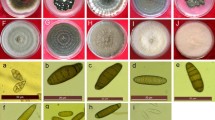Abstract
Fusarium crookwellense was isolated for the first time in Japan from scabby wheat harvested in Hokkaido in 1991. Four isolates were obtained and examined for their mycological features on culture media, mycotoxin production, and pathogenicity to wheat and barley. The texture of fungal colonies and the morphology of macroconidia on a potato dextrose agar medium were similar to those ofFusarium graminearum. AllF. crookwellense isolates examined produced nivalenol, 4-acetylnivalenol, and zearalenone on rice media at levels ranging from 0.9 to 22.5 µg/g, 0.5 to 25.0 µg/g, and 1.4 to 162.5 µg/g, respectively. All were pathogenic toward the wheat and barley strains tested, and scab symptoms were found on the heads and leaves of plants. This is the first report on domestic isolates ofF. crookwellense from the crop field in Japan.
Similar content being viewed by others
Literature cited
Bottalico, A., Logrieco, A. and Visconti, A. 1990. Mycotoxins produced byFusarium crookwellense. Phytopath. Medit.29: 124–127.
Burgess, L. W., Nelson, P. E. and Toussoun, T. A. 1982. Characterization, geographic distribution and ecology ofFusarium crookwellense sp. nov. Trans. Br. Mycol. Soc.79: 497–505.
Frisvad, J. C. and Samson, R. A. 1991. Filamentous fungi in foods and feeds: ecology, spoilage, and mycotoxin production. In: “Handbook of Applied Mycology, Vol 3, Foods and Feeds,” (ed. by Arora, D. K., Mukerji, K. G. and Marth, E. H.), pp 31–68. Marcel Dekker, New York.
Golinski, P., Vesonder, R. F., Latus-Zietkiewicz, D. and Perkowski, J. 1988. Formation of fusarenon X, nivalenol, zearalenone, α-trans-zearalenol, β-trans-zearalenol, and fusarin C byFusarium crookwellense. Appl. Environ. Microbiol.54: 2147–2148.
Ichinoe, M., Hagiwara, H. and Kurata, H. 1983. Distribution of trichothecene-producing fungi in barley and wheat fields in Japan. In: “Developments in Food Science Vol 7, Toxigenic Fungi-Their Toxins and Health Hazard,” (ed. by Kurata, H. and Ueno, Y.), pp. 190–198. Elsevier, Amsterdam.
Koizumi, S., Kato, H., Yoshino, R., Hayashi, N. and Ichinoe, M. 1991. Distribution of causal fusaria of wheat and barley scab in Japan. Ann. Phytopath. Soc. Japan57: 165–173.
Lauren, D. R., Sayer, S. T. and Menna, M. E. 1992. Trichothecene production byFusarium species isolated from grain and pasture throughout New Zealand. Mycopathologia120: 167–176.
Miller, J. D., Greenhalgh, R., Wang, Y.-Z. and Lu, M. 1991. Trichothecene chemotypes of threeFusarium species. Mycologia83: 121–130.
Nelson, P. E., Toussoun, T. A. and Marasas, W. F. O. 1983. “Fusarium species, an illustrated manual for identification,” The Pennsylvania State University Press, PA. 193p.
Nirenberg, H. I. 1990. Recent advances in the taxonomy ofFusarium. Stud. Mycol.32: 91–101.
Sugiura, Y., Fukasaku, K., Tanaka, T., Matsui, Y. and Ueno, Y. 1993.Fusarium poae andFusarium crookwellense, fungi responsible for the natural occurrence of nivalenol in Hokkaido. Appl. Environ. Microbiol.59: 3334–3338.
Tanaka, T., Hasegawa, A., Matsuki, Y., Ishii, K. and Ueno, Y. 1985a. Improved methodology for the simultaneous detection of the trichothecene mycotoxins deoxynivalenol and nivalenol in cereals. Food Additi. Contam.2: 125–137.
Tanaka, T., Hasegawa, A., Matsuki, Y., Matsui, Y., Lee, U-S. and Ueno, Y. 1985b. Co-contamination of theFusarium mycotoxins, nivalenol, deoxynivalenol, and zearalenone, in scabby wheat grains harvested in Hokkaido, Japan. J. Food Hyg. Soc. Japan26: 519–522.
Tanaka, T., Hasegawa, A., Yamamoto, S., Toyazaki, M., Matsuki, Y., Sugiura, Y. and Ueno, Y. 1987. Production of mycotoxins byFusarium isolates from scabby wheat harvested in Hokkaido, Japan. Proc. Jpn. Assoc. Mycotoxicol.25: 31–33.
Tanaka, T. and Ueno, Y. 1989. Worldwide occurrence ofFusarium mycotoxins, nivalenol, deoxynivalenol and zearalenone. In: “Mycotoxins and Phycotoxins '88,” (ed. by Natori, S., Hashimoto, K. and Ueno, Y.), pp. 91–97. Elsevier, Amsterdam.
Thrane, U. 1990. GroupingFusarium section Discolor isolates by statistical analysis of quantitative high performance liquid chromatographic data on secondary metabolite production. J. Microbiol. Methods12: 23–39.
Ueno, Y. 1986. Trichothecenes as environmental toxicants. Rev. Environ. Toxicol.2: 303–341.
Ueno, Y. 1987. Trichothecenes in food. In: “Mycotoxins in Food,” (ed. by Krogh, P.), pp. 123–147. Academic Press, London.
Author information
Authors and Affiliations
About this article
Cite this article
Sugiura, Y., Saito, H., Tanaka, T. et al. Fusarium crookwellense, a newly isolated fungus from wheat in Japan: Its mycotoxin production and pathogenicity to wheat and barley. Mycoscience 35, 77–82 (1994). https://doi.org/10.1007/BF02268532
Accepted:
Issue Date:
DOI: https://doi.org/10.1007/BF02268532




